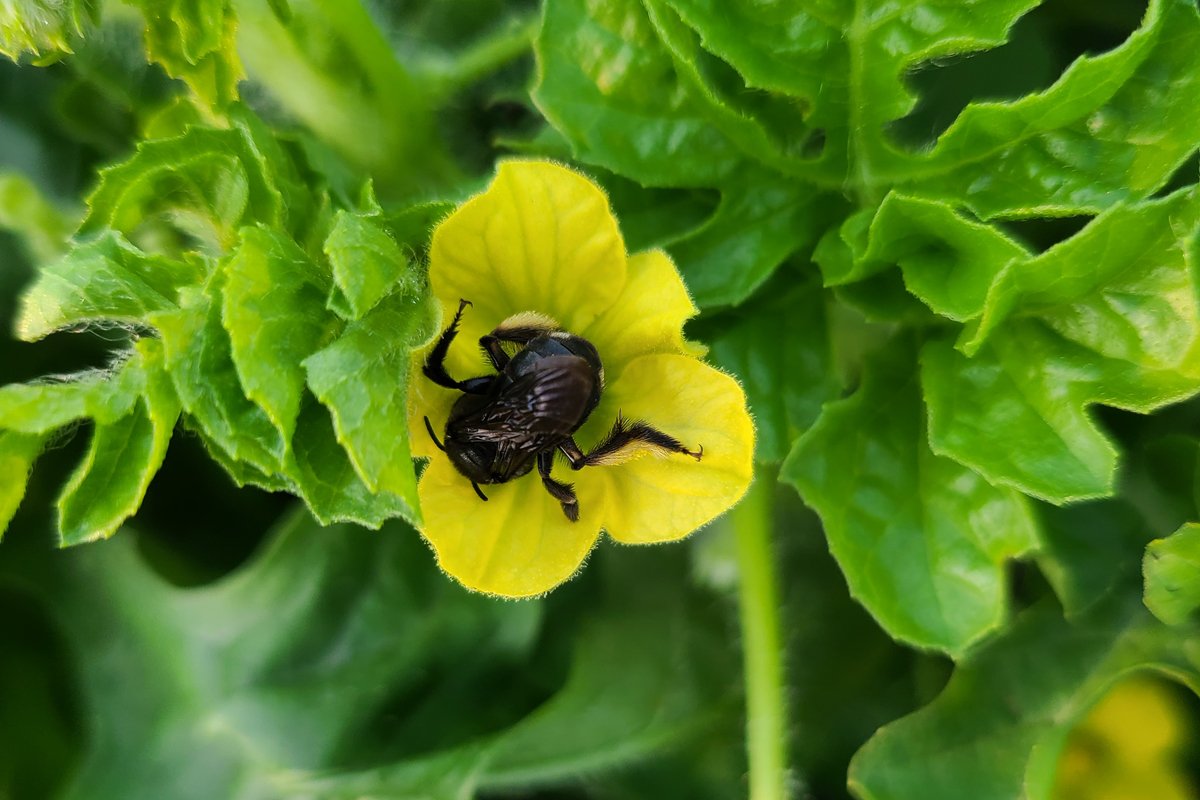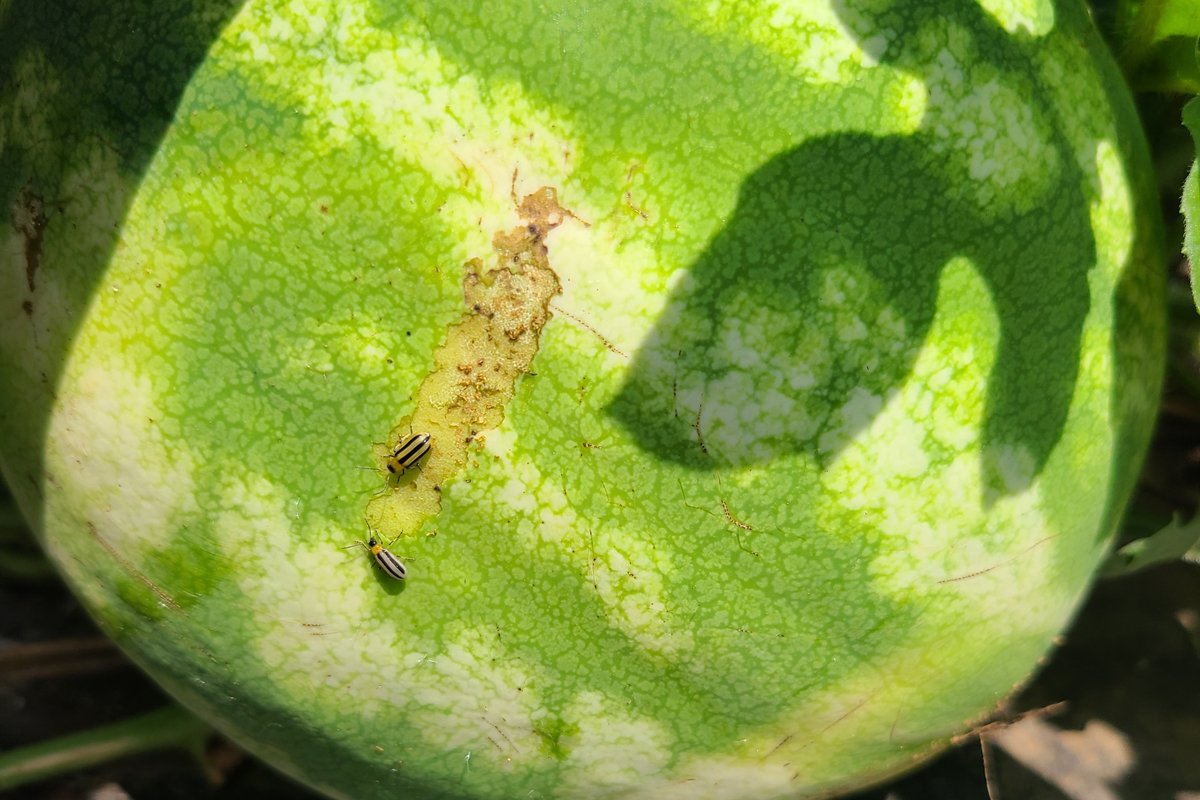A new study focused on watermelons has wider implications for how farmers can strike a balance between predation and pollination in the produce industry.

A new study focused on watermelons has wider implications for how farmers can strike a balance between predation and pollination in the produce industry.
January 31, 2023

A two-spotted long horn bee visits a watermelon flower (Photo credit: Ashley Leach)
Ashley Leach shops for groceries a little differently than most people. An applied entomologist at Ohio State University, Leach can look at oranges, apples, and watermelons and see the bite scars and other marks left by insects on their journey to the produce aisle.
“I always take pictures of produce in the grocery store,” says Leach. “Watermelon is always the one that looks a little more loved.”
That’s because watermelon’s thick rind can take a lot of damage from pests, like the striped cucumber beetle, before they affect the fruit underneath. But, like many crops, watermelon plants must be pollinated to bear fruit, and it’s the effort to find a balance between help and harm, predation and pollination, that drives much of Leach’s work.
Over the course of two years, the only thing that significantly affected the production of marketable watermelons was the number of visits bees made to pollinate the plants.
In a study published in the November issue of Proceedings of the Royal Society, Leach and her colleague Ian Kaplan from Purdue University took a closer look at that equation in the case of the popular melons and found surprising evidence that, in some cases, pollination is more important than pest activity in impacting a farm’s productivity.
Leach and Kaplan ran a controlled experiment to test insects’ impact on watermelon yield. They chose to vary the density of both pollinators and pests, unlike previous studies, which focused on simple presence and absence. It’s typically “what do we do when we have beetles? What do we do when we don’t have beetles? Same with bees,” says Leach. “That’s nice, but it’s not realistic.”
They expected to find a complex interaction, with both factors working in tandem to affect yield. What they saw was much more straightforward. Over the course of two years, the only thing that significantly affected the production of marketable watermelons was the number of visits bees made to pollinate the plants. The beetles, even in significant numbers, didn’t make a dent. They also found that density of wild bee pollinators had a greater effect than that of domesticated honeybees, especially in the case of larger-bodied and hairier species like bumblebees, which are able to carry large amounts of watermelons’ relatively heavy pollen.
Modern pest control is often run on what’s called a threshold principle. The idea is that for each crop, there is a point of pest or disease damage that starts to affect its value. Below that threshold, there is no need to interfere. Beyond it, there may be a need to apply some treatment—chemical, biological, or otherwise—to mitigate the damage. For Midwestern melon farmers, Leach says that the threshold is widely considered to be between two and five beetles per plant. The researchers found no effect on yield even at densities of nine beetles per plant, where conventional wisdom would suggest spraying pesticides to knock back the bugs. It suggests that, at least in some situations, melon farmers could get the same yield result with less pesticide use, a win-win for both the environment and growers.
As consumers, we often think of pesticide as a black-and-white choice—organic or conventional, yes or no. But on the ground and in the fields, it’s typically more complicated than that. Both conventional and organic farmers have to make nuanced decisions about which treatment to use, how much, and when.

Feeding damage on this watermelon fruit was caused by the striped cucumber beetle. (Photo credit: Ashley Leach)
Modern industrial agriculture has largely been focused on simplifying a complex system, with the goal of more reliable harvests. The trend throughout the 20th century was toward larger fields of a single crop, replacing the tangle of nature with ruler-straight rows and perfectly square or circular fields. That paradigm has been successful in terms of yield but has come with mounting side effects such as topsoil loss, air and water pollution, worker exposure to pesticides, and more. The idea of encouraging wild pollinators goes against that basic approach. Instead, it’s telling farmers to make their systems more diverse, and therefore more complicated, and that can understandably be a tough sell.
Leach knows that one study is unlikely to radically change any particular farmer’s system. That takes time and repeated results. She also recognizes that every field is different, with different pests, pollinator communities, climate conditions, and other variables that affect the relationship between a farm and its insects.
“I’m a big believer, when it comes to agriculture, and when it comes to pest management, that the devil is in the details,” adds Leach.
To Joe Del Bosque, the details are everything. He has been growing melons on his large farm in California’s Central Valley since 1985 and has been involved in the business for more than six decades, starting as a farmworker after his parents immigrated from Mexico. The melons on Del Bosque Farm have been grown organically for 17 years, but the farm grows other crops, including asparagus, almonds, and cherries, in both organic and conventional systems.
“All things are important,” Del Bosque says. “Pollinators are important. We deal with the same beekeeper that we’ve been working with for 37 years. Actually, we’re working with the granddaughter of the original beekeeper now.”
“And as far as pest control, it’s vital,” he adds. Over the years, Del Bosque has seen both the benefits and costs of going organic and limiting pesticide use on his farm. He lost his last few fields of melons last year to an aphid outbreak. But as an early adopter of pollinator-friendly practices like planting hedgerows or rows of flowers specifically to feed bees, he also knows the value that a thriving community of wild and domesticated pollinators can bring to a farm’s bottom line.
One challenge of growing melons organically is communicating those risks and benefits to the consumer, especially since it results in higher prices.
“We try to get our customers to understand that we do need higher prices for this sort of a product,” says Del Bosque. “It costs more. We need to get more.” Ironically, one big difference between his experience and Leach’s study in the Midwest—and an added challenge to going pesticide free—is his customers’ reaction to external damage like beetle scars on the rinds of his melons. Just because they want a more natural fruit doesn’t necessarily mean they will accept the imperfections that come with natural management.
“Yield, at the end of the day, is the most valuable metric for growers.”
“A lot of our customers do not want any insect damage, scars, or anything like that on the fruit. Even if it doesn’t really affect the quality or the eating properties of the fruit, it’s unattractive and they don’t want it.”
California has a variety of grants and programs to encourage farmers to use more sustainable practices. But one program that helped Del Bosque make the difficult and often expensive transition to organic decades ago has since been discontinued.
“We got into the Sustainable Farm Project before we were organic farmers, and we learned a lot of practices that would later become important in our organic farming,” Del Bosque says. “It would be great if the state would fund those types of programs to help farmers understand how they can adapt more sustainable practices.”
Luckily, there are nonprofits and other services to step in and fill that gap, including the Xerces Society for Invertebrate Conservation, an organization that encourages pollinator-friendly habitats on farms. As a pollinator habitat specialist for Xerces, Anna Murray makes the case to Western farmers that native bees can help both their land and their business, and she works with them to bring that habitat to their farms. Like Leach, she sees both the potential and limitations of the new study.
“Yield, at the end of the day, is the most valuable metric for growers,” says Murray, who was not involved in the Ohio State study. “You can never say to a particular grower, ‘you’re going to get X amount of pollination services from wild pollinators’ because of all of the complexity of their agroecosystem. But studies like this do help get folks on board.”
She points out that there are more than 3,600 species of native wild bee in North America, with 1,600 in California alone. Most are solitary nesters, unlike hive-nesting honeybees, making them difficult or impossible to domesticate. Instead, their conservation depends on restoring habitat and limiting the pesticides that can inadvertently harm them along with the intended pest targets.
While Xerces’ mission focuses on conserving wild insects, and studies like Leach’s show the value of those wild species above and beyond domesticated honeybees, Murray points out that those kinds of management practices can be a win-win for both.
“Often the honeybee suppliers are thrilled to see the work that we’re doing,” Murray says. “If we put in a habitat, they have somewhere to keep their hives through the winter, or they have somewhere to put their hives where there’s more nutritional balance and less disease pressure.”
As overall insect numbers have plummeted in recent years, Murray acknowledges that the insect conservation picture as a whole is looking bleak. “But at the same time, we do have people recognizing that,” she added. “There’s a lot of growing intuitive understanding of why insects matter, about what they can do for both the grower and for our landscape overall. So, I’m optimistic.”
Leach shares that optimism and sees a difference between what she reads in the academic literature and what she sees on the ground. National studies consistently report that although farmers are becoming more aware of the benefits of pollinators, they have been slow to act and take up pollinator-friendly policies. Yet, when she visits local farms and talks with farmers, she sees signs of change.
“My personal experience has been shifting. I’ve walked on to more farms that are growing pollinator-dependent crops, and I’ve been pretty surprised. I’m like, ‘What? You’re planting vacant, dead land with wildflowers? All the papers tell me you’re not supposed to exist.’”

October 9, 2024
In this week’s Field Report, MAHA lands on Capitol Hill, climate-friendly farm funding, and more.
October 2, 2024

October 2, 2024

October 1, 2024

September 30, 2024

September 25, 2024

September 25, 2024

Like the story?
Join the conversation.